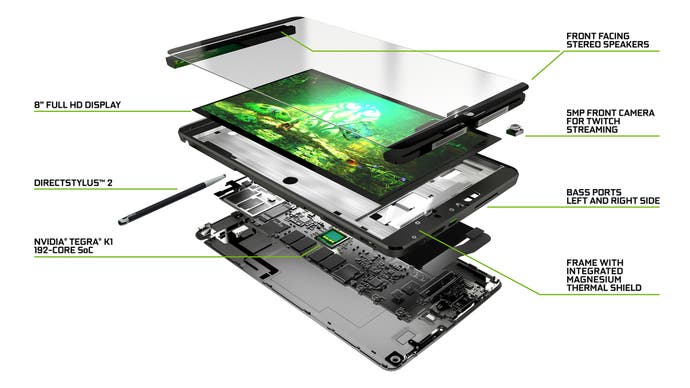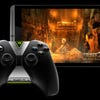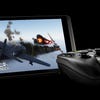Digital Foundry: Hands-on with Nvidia Shield Tablet
Micro-console meets tablet meets PC gameplay extender.
Nvidia's sequel to its Shield handheld is set for release in the US at the end of the month - and a European release a few weeks later - and takes the form of a high-quality eight-inch tablet with an optional console-quality wireless controller. The firm's state-of-the-art Tegra K1 processor - with 2x the graphics power of the iPad Air - beats at the heart of the new device, set to go on sale for $299 in North America, and £229 in the UK.
We went hands-on with the device at an Nvidia press event on 14th July, which proved an interesting experience bearing in mind that we were in the midst of our Xiaomi MiPad review at the time. The import-only Chinese tablet is notable in that it's based on the exact same Tegra K1 chipset, so we should expect similar baseline performance from the silicon, but in practice, the two tablets share less in common than you may think. The MiPad aims squarely at an iPad mini-style experience, whereas Shield Tablet comes across as a much more gamer-orientated offering.
Perhaps the biggest difference is the all-important display configuration. Xiaomi opts for a 4:3 IPS display with a 2048x1536 resolution - the same baseline spec as the iPad mini with Retina display. Nvidia has positioned Shield tablet first and foremost as a gaming device, so resolution on the IPS display drops to 1920x1200, and we have a 16:10 aspect ratio. While we didn't have the two devices side-by-side, it's safe to say that what Shield Tablet loses in terms of pure pixel density, it gains with a display that isn't just better for gaming, but works more comfortably for widescreen media content too.
That's augmented by a bundled stylus, based on Nvidia's DirectStylus 2 - an enhanced version of the technology found on the cheap 'n' cheerful Tegra Note 7. There's no digitiser built into the tablet as you might find in the Surface Pro line; instead it's based on the capacitive screen, with pressure calculated according to how much of the stylus nib is in contact with the screen. A watercolour painting 'simulator' called Dabbler is included in the package, designed to showcase what the stylus is capable of - Nvidia says that there's a 2x increase in precision compared to the Note 7 implementation.
Then there's the operating system. Both are based on Android, but whereas Xiaomi uses its own MIUI skin, Shield Tablet relies on something very close to the stock OS, albeit with a bunch of additional tools, such as the Shield portal for accessing specific titles that work best with the device, along with Tegra exclusives. The Shield handheld's console mode is retained, allowing users to shut off the main screen and divert all system resources to the HDMI output (the standard tablet 'mirroring' solution impacts bandwidth, leading to reduced performance), while Nvidia's GameStream remote play technology is also incorporated.
On top of that, an interesting new feature comes in the form of full Twitch streaming integration - you can broadcast your Android gameplay live, complete with picture-in-picture feed from the front-mounted webcam. We're told that this works in GameStream mode too, meaning you can tap into your PC games library remotely, and stream it via Twitch using Shield tablet. Nvidia also reckons it has a negligible hit on game performance, something we look forward to testing when we review the device.
Another interesting addition is a gamepad-mapper, allowing you to map traditional touch-screen controls onto the joypad - the idea here being that touch-only titles become playable in a more traditional console-like manner. And that's where Nvidia's wireless controller comes in. The firm included Bluetooth controller support with the Shield handheld for console mode, but came away from the experience thinking it could do better. The new wireless controller feels similar to the excellent pad on the old Shield handheld, but benefits from a high-end WiFi connection, with higher levels of data throughput and lower latency than a Bluetooth controller. The pad includes a touchpad in its lower centre and a microphone too, and multiple pads can be paired with the tablet via a bespoke app.
The pad itself is an optional extra - it's not included in the box. Its costs are in line with those of a next-gen console: $60 in the US and around the £40 mark in the UK. In addition to that, there's a smart cover, serving the same purpose as the iPad equivalents - it attaches magnetically, protects the screen and serves as a stand.

Overall, while the Xiaomi MiPad clearly has much in common with the Shield Tablet, there is much to differentiate the two - and it all comes down to software, and not just OS embellishments. We saw Half-Life 2 and Portal running on the device, with significant image quality improvements over the same code running on Tegra 4, giving a far more PC-like experience.
We also saw Frozenbyte's Trine 2 - bundled free with the device - running at 720p in the same 30fps ballpark as the Xbox 360 and PlayStation 3 versions of the game (how it stands up to the console versions is something we'll look at more closely next week). Early code for War Thunder also looked very impressive, though we hope that optimisations can produce a more consistent frame-rate.
There's talk of 11 titles with specific K1 optimisation in the pipeline - and it's essential that Nvidia pushes forward with this initiative for the Tegra platform to gain momentum. Trine 2 demonstrates what happens when you develop with the K1 hardware in mind, while the range of Android titles we tested in the MiPad review reveals a clear level of diminishing returns when less ambitious titles are run on the more advanced hardware. In effectively taking leadership in the mobile arms race, Nvidia needs to consistently demonstrate that the buy-in on the hardware will result in tangibly better gameplay.
Perhaps the biggest surprise from our time with the hardware was our initial shock at Nvidia's decision to turn its back altogether on the handheld form-factor. Many others have made tablets, but there was nothing on the market as focused on Android gaming as Shield. We can't help but conclude that Nvidia's initial offering was simply too niche. A separate control pad isn't an elegant solution for gaming outside the home, but it's clear that the tablet form-factor is more desirable overall, with more use-case scenarios. In short, there's a reason we pack a tablet in our travel bag more often than our Tegra 4 Shield - there's simply more we can do with it.
The second-biggest surprise from the press event? The no-show of the 64-bit version of the Tegra K1. Shield Tablet features the same 32-bit rendition as found in the MiPad, with the same ARM Cortex A15 quad-core configuration as Tegra 4, albeit boosted up from 1.9GHz to 2.2GHz with some additional efficiency enhancements.
The 64-bit version uses two high-power 'Denver' cores instead, which we suspect will show dramatic improvements over the 32-bit A15 version. The fact that Nvidia has revealed a flagship device without the flagship 64-bit K1 silicon is surprising, and we wouldn't be surprised at all to see the Denver CPU delayed until next year, matched up with a mobile version of the next-gen Maxwell graphics core (as found in the GTX 750 Ti desktop graphics card).
Finalising our Tegra K1 MiPad review, we loved the hardware but found games performance to be lacklustre. While we still have misgivings about Android's suitability as a core gaming platform after our experiences with the Amazon Fire TV and the Mad Catz Mojo, it's clear that Nvidia has made real efforts here to be push boundaries on the platform - it's a state-of-the-art Android device with exclusive functionality like Twitch and GameStream, while titles like Trine 2 suggest that last-gen console visuals and gameplay may well be within reach on ultra-power-efficient hardware.
Shield Tablet releases on 29th July in the US and 14th August in Europe, and we'll have a full review next week.











.png?width=291&height=164&fit=crop&quality=80&format=jpg&auto=webp)

